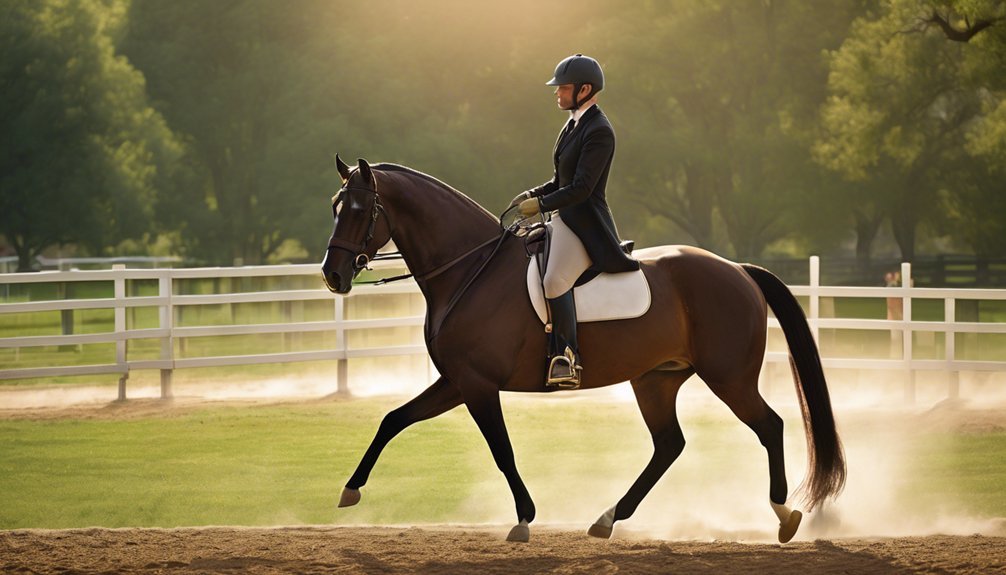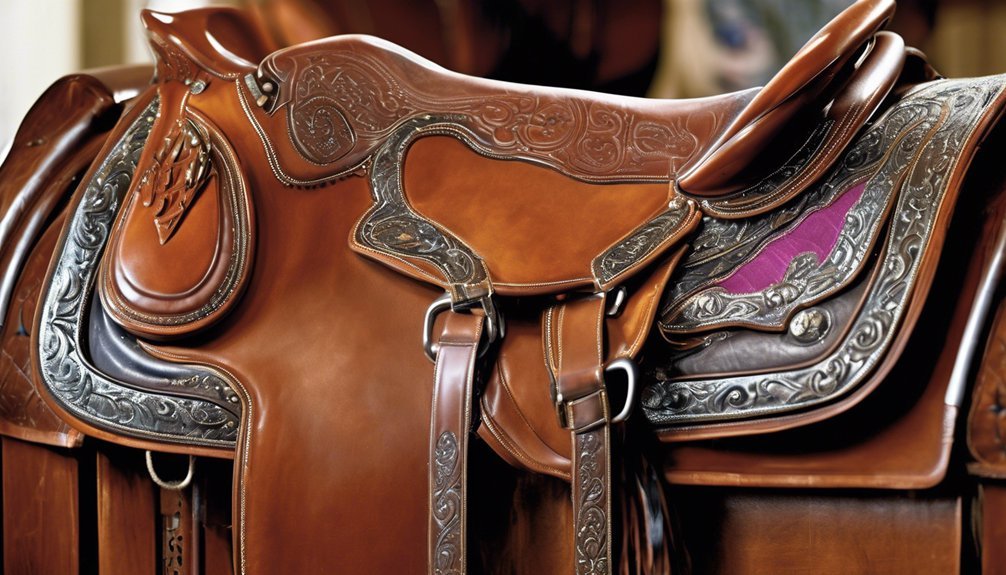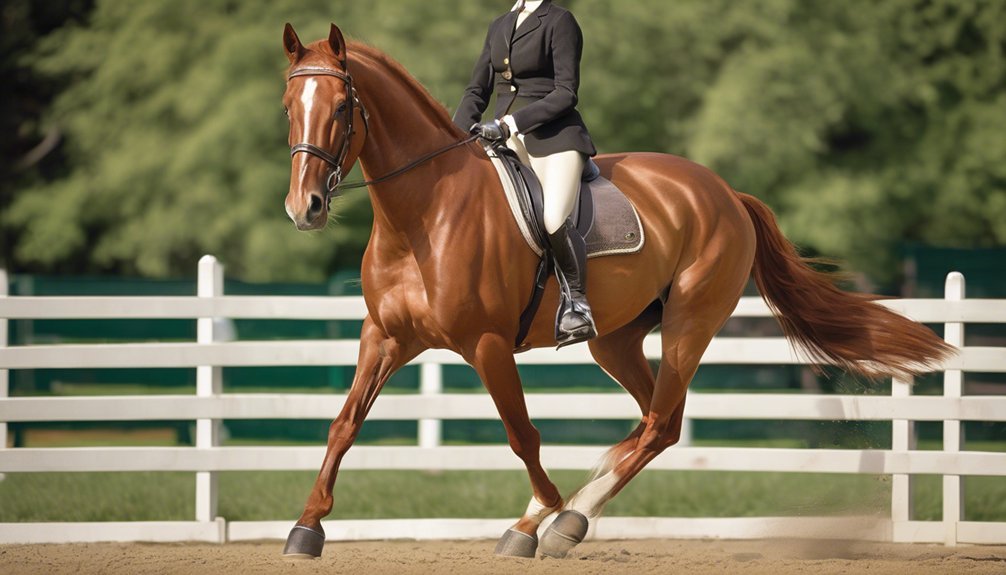
Did you know that in eventing competitions, the difference between first and second place can be as small as a single penalty point? Understanding the intricate scoring system is essential for both competitors and spectators alike. Each phase—dressage, cross-country, and show jumping—carries its own unique scoring criteria. But how do these penalties accumulate, and what does it mean for the final outcome? Let's unpack the details to clarify this complex scoring landscape.
Key Takeaways
- Eventing scoring combines penalties from dressage, cross-country, and show jumping to determine the final score.
- Dressage is scored on a scale from 0 to 10, with each movement contributing to the total score.
- Cross-country incurs time penalties for exceeding the optimal time and additional points for refusals or knocked obstacles.
- Show jumping penalties arise from faults like knocking down rails and exceeding time limits, affecting the overall score.
- The competitor with the lowest cumulative score from all phases wins the event.
Overview of Eventing Scoring

When you dive into eventing competitions, understanding the scoring system is crucial for both competitors and spectators alike.
The eventing scoring system has evolved significantly throughout eventing history, reflecting changes in competition standards and rider expectations. Essentially, scores are derived from penalties incurred during the dressage, cross-country, and show jumping phases.
Each phase has specific criteria, and penalties are assigned for faults, such as refusals or time penalties. The overall goal is to minimize penalties, as the competitor with the lowest score wins.
Dressage Scoring Explained
Understanding dressage scoring is essential, as it forms the foundation of eventing competitions.
You'll see that each performance is evaluated based on specific dressage movements, with judges assessing precision, fluidity, and overall harmony between horse and rider. The scoring criteria typically range from 0 to 10, with 10 being exceptional.
Each movement earns a score, reflecting its quality, while collective marks evaluate the overall impression. It's crucial to understand how these scores contribute to your total, as a strong dressage performance can set the stage for success in the event.
Understanding Cross-Country Scoring
While the transition from dressage to cross-country may seem daunting, grasping the scoring system can significantly impact your performance.
Understanding the scoring nuances will help you navigate the course effectively. Here are key factors to consider:
- Time penalties: Every second over the optimum time results in penalties.
- Refusals: Each refusal at cross country obstacles adds points to your score.
- Eliminations: A fall or exceeding the time limit can result in elimination.
- Jumping penalties: Hitting a rail or knocking down an obstacle incurs additional points.
- Course familiarity: Knowing the layout can help you anticipate challenges.
Show Jumping Scoring Breakdown

In show jumping, scoring hinges on precision and performance, as each fault can significantly impact your final score.
You'll need to master effective show jumping techniques to navigate the course design successfully. Every jump demands accuracy; knocking down a rail incurs penalties that can quickly add up.
Additionally, time is a critical factor. If you exceed the allotted time, you'll face extra penalties that can jeopardize your ranking.
Understanding the layout and challenges presented by the course design helps you strategize your approach and minimize faults.
You want to ensure that you and your horse communicate seamlessly, showcasing your skills while adhering to the scoring rules. This awareness creates a sense of camaraderie among competitors striving for excellence.
Penalties and Their Impact
Penalties in eventing can dramatically alter your overall score, influencing not just your position in the rankings but also your strategy for future competitions.
Understanding the various penalty types can help you make informed decisions to minimize your score. Here are some key penalty types to consider:
- Refusals: A horse's refusal to jump incurs major penalties.
- Knockdowns: Each knocked-down rail adds to your score.
- Time Penalties: Exceeding the time limit can lead to significant deductions.
- Fall of Horse or Rider: This results in elimination and no scoring.
- Incorrect Course: Misjudging the course can lead to hefty penalties.
The Role of Time in Scoring
Understanding penalties is just the beginning; time plays a pivotal role in scoring during eventing competitions. As a competitor, you need to grasp that every second counts.
If you exceed the optimal pacing for your course, you'll incur time penalties, which can significantly affect your overall score. Balancing speed and control is essential; you want to navigate the course efficiently without sacrificing your horse's performance.
It's crucial to develop a strategy that allows you to maintain a competitive pace while ensuring accuracy in jumps. Remember, a well-timed ride not only showcases your skills but also keeps you in the running for top placements.
Embracing the importance of time can elevate your performance and enhance your connection with the sport.
Final Scoring Calculations

While you may have mastered the intricacies of individual phases in eventing, the final scoring calculations can be a bit complex. Your final score isn't just a single number; it's a culmination of various scoring factors that you need to consider:
- Dressage penalties
- Cross-country time penalties
- Show jumping penalties
- Any additional faults
- Overall time used
To arrive at your final score, you'll subtract any penalties from your base score. Each phase contributes uniquely, and understanding how they interact can elevate your competitive edge.
Importance of Consistency in Eventing
Consistency is the cornerstone of success in eventing, where every phase demands not just skill but reliability. To achieve performance stability, you must focus on a comprehensive training regimen that enhances both horse and rider capabilities. Without this consistency, even the most skilled competitors can falter under pressure. Here's a quick overview of how consistency impacts your performance:
| Aspect | Impact on Performance |
|---|---|
| Training Routine | Builds muscle memory |
| Competition Readiness | Reduces anxiety |
| Scoring Reliability | Increases overall scores |
Tips for Aspiring Competitors
As you embark on your journey in eventing, remember that preparation extends far beyond just mastering the skills required for each phase. Here are some essential tips to enhance your experience and performance:
- Focus on training techniques that suit both you and your horse.
- Develop a consistent routine to build familiarity and confidence.
- Engage in mental preparation to handle competition pressure effectively.
- Seek feedback from experienced riders and coaches to refine your approach.
- Stay connected with the eventing community for support and shared experiences.
Frequently Asked Questions
How Are Ties Broken in Eventing Competitions?
In eventing competitions, you'll find tie breaking methods prioritize scoring criteria like time penalties and performance metrics. Understanding these methods ensures you appreciate how results are determined, fostering a deeper connection with the sport's competitive nature.
What Is the Significance of the Optimum Time?
When it comes to eventing, hitting the optimum time's crucial. It not only affects your score but also showcases your horse's and your skills. Knowing this can make all the difference in competitive success.
Can Riders Choose Their Dressage Test?
You can't choose your dressage test; specific tests are assigned based on the competition level. Understanding these selections helps you align your training with rider preferences, ensuring you and your horse perform at your best.
How Are Judges Trained for Scoring?
Judges undergo extensive training in judge education, focusing on scoring criteria to ensure fairness and consistency. They practice evaluating performances, refining their skills, and developing a keen eye for detail, which ultimately enhances the competition experience for everyone involved.
Is There a Maximum Score in Dressage?
So, you think there's a magic number for dressage scoring? Not quite! While judges evaluate performance, there's no strict maximum score; it's all about how well you and your horse show off those fancy moves!
Conclusion
In conclusion, mastering the eventing scoring system is essential for achieving success in competitions. Did you know that the average winning score in a three-phase event often hovers around 30 penalties? This statistic underscores the importance of minimizing errors in each phase. By understanding how each component affects your overall score, you can strategize effectively, enhance your performance, and ultimately improve your chances of standing on the podium. Stay focused, practice consistently, and you'll see results!





